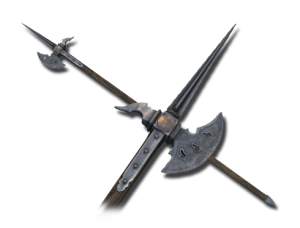
| |
| Halberd | |
| Damage |
■■■■■■□□□□ 56% |
| Speed |
■■■■■□□□□□ 50% |
| Range |
■■■■■■■■□□ 83% |
| Weapon Type |
Polearms |
"The Halberd is primarily used as a stab weapon though overhead strikes can deal significant damage as well due to the massive total weight of the weapon."[1][1]
It is the third unlockable Pole Arm for the Vanguard.
This weapon is considered to be one of the most versatile polearms in the game, as it holds a decent amount of reach, speed and damage. In spite of the weapon's description, the Halberd has become quite famous as a swing-heavy weapon much like its predecessors the Bardiche and Billhook, rather than the "stab weapon" it was potrayed as. Regardless, the Halberd is a fairly popular choice on the battlefield thanks to its ease of use and relatively high range/damage for both its swing and stab.
Like other "axes," it does Swing-Blunt damage with both swings. Being part spear, it also does powerful pierce with its stab.
Like other mid-range weapons, it is recommended to bring a secondary you are comfortable with when entering tight corridors or fighting aggressive enemies at extremely close range as it is easy for polearms to get overwhelmed.
Similar to the Warhammer, the spike on the backside of the blade cannot currently be used to attack enemies.
Trivia[]
The Halberd wasn't actually designed for combat against infantry (as used in Chivalry). Rather, the weapon was designed as an anti-cavalry weapon, often used by large units of men in a Phalanx-like spear-wall formation, with the front rank crouching and the next ranks positioning their Halberds between those of the forward ranks, similarly to how a pike formation would have been arranged. The spear tip could be used to attack charging (unarmored) horses and the "axe" side being high enough to hit enemy riders from atop their horse. The spike on the back of the blade could be used to pull enemy riders off their saddle. However, it eventually adapted for more versitile use as time progressed, making its appearance in Chivalry less surprising.